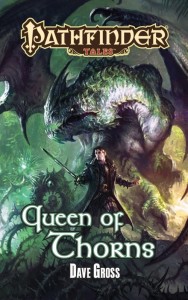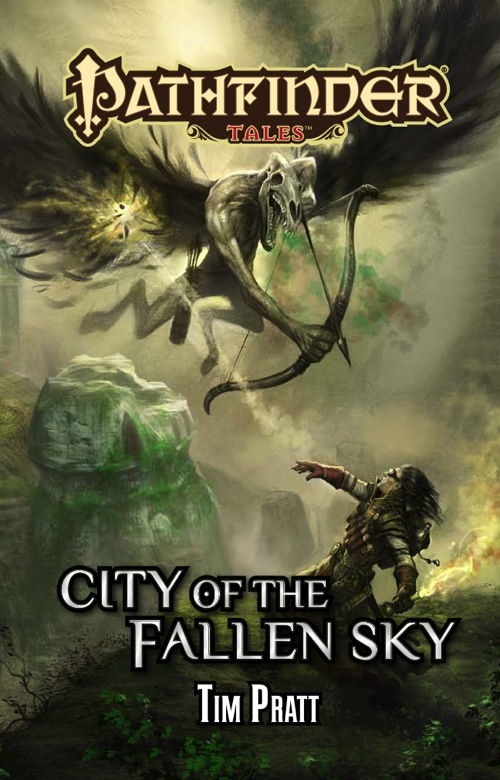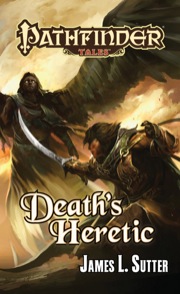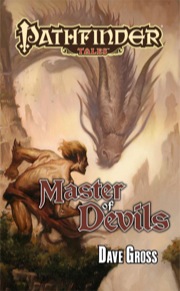 This interview is a repost from a past interview I did for the Seekers of Secrets Pathfinder blog. The original interview on that blog is no longer accessible, I wanted to preserve the interview here at The Iron Tavern.
This interview is a repost from a past interview I did for the Seekers of Secrets Pathfinder blog. The original interview on that blog is no longer accessible, I wanted to preserve the interview here at The Iron Tavern.
Seekers of Secrets recently had the privilege to interview Dave Gross, the author of the upcoming Pathfinder Tales novel Master of Devils. Pathfinder Tales is the fantasy fiction line published by Paizo. Master of Devils is the fifth novel in the line and is due for release on August 4th.
Dave Gross has a strong presence within the Pathfinder Tales line with his tales featuring Count Varian Jeggare and his bodyguard Radovan. Dave wrote the first novel to kick off the Pathfinder Tales novel line with Prince of Wolves. He also has written Hell’s Pawns (appeared in the Council of Thieves Adventure Path), Husks (appearing in the upcoming Jade Regent Adventure Path) and the short stories The Lost Pathfinder and A Lesson in Taxonomy which appeared in the web fiction published weekly on Paizo’s site. He also co-wrote Winter Witch with Elaine Cunningham.
Master of Devils finds Count Jeggare and Radovan in Tian Xia, the far side of Golarion on a mission for the Pathfinder Society. The Count sheltering in the Dragon Temple and Radovan trapped in the body of a devil, held hostage by the Quivering Palm, learning the secret of conquering an immortal enemy culminating in an ultimate showdown with the Master of Devils. The book is an excellent read and certain to thrill fantasy readers of all types!
And with that, let the interview begin!
_______________________
Your work for Pathfinder Tales is written from a first person point-of-view perspective and in addition alternates between characters with this style of perspective. What led you to choose this perspective in your writing? What advantages do you find this perspective brings? What challenges do you find this perspective bring to your writing?
When Paizo’s fiction editor, James Sutter, first talked to me about writing Pathfinder fiction, we batted around a few ideas, one of which became “Hell’s Pawns,” a novella that introduced the characters of Radovan and the Count. My initial thought was to tell the story from the points-of-view of both characters, alternating between their experiences in low and high society. As the outline took shape, however, I began to feel there wasn’t room in six chapters to do that effectively, so I decided to limit the narrative to a single point of view.
I focused on Radovan, who in the pitch was a kind of Watson to Jeggare’s Holmes. Around that time I’d been watching a lot of film noir, so “Watson” soon became a tough guy in the mold of Sam Spade or Philip Marlowe. At that point it seemed natural to tell the story from only Radovan’s point of view—in first-person and in present tense, like a hard-boiled detective story.
When James asked for novel pitches featuring the same characters, I wanted to add Jeggare’s POV to the story. That way I could take the reader places where Radovan wasn’t welcome, and I could sometimes show the same scene from conflicting perspectives. Also, alternating POVs gave me another tool for building suspense.
After outlining Prince of Wolves, I wasn’t sure first-person would work for Jeggare, and I suspected present-tense was wrong for him too. In fact I wrote the first four or five chapters in third-person, once in present tense and once in past, before switching to the alternating first-person past-tense once I found Jeggare’s voice. The flash-forward prologue remains in present-tense, which I figured was a good way to establish that it appeared out of sequence. It was my idea of a teaser movie trailer.
What I like about the alternating first-person is that it lets me switch from hard-boiled detective to Merchant Ivory period dramas, both of which I love. It lets me emphasize with voice the different worlds in which Radovan and the Count live, and it helps me demonstrate their different reactions to the same characters and events.
One challenge I face with this approach is that I notice each character’s voice intruding sometimes on the other’s narrative. That’s the first thing I look to revise after the first draft, but every once in a while I try to use it to build the relationship between the two men. If I catch a high-falutin’ word in a Radovan chapter, for instance, I might rewrite the line ironically: “It was what the boss might call ‘copious’ bleeding,” for example.
Count Jeggare and Radovan and appear to be quite popular characters amongst the followers of Pathfinder fiction. What do you think explains their popularity among the Pathfinder Tales fans?
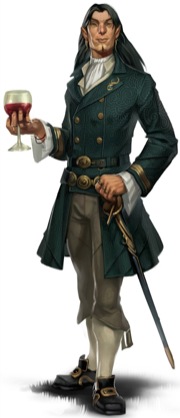 I can’t really speak for others, but what I like about them is that they’re the classic odd couple. Their differences offer me lots of opportunities for both drama and humor. And neither of them is a sidekick, even though Radovan is the Count’s employee. Either one could be the hero of his own story. In fact, one of the pitches for the novel that became Prince of Wolves was a Radovan-only novel. I get the impression that while many readers like them both, most everyone has a favorite.
I can’t really speak for others, but what I like about them is that they’re the classic odd couple. Their differences offer me lots of opportunities for both drama and humor. And neither of them is a sidekick, even though Radovan is the Count’s employee. Either one could be the hero of his own story. In fact, one of the pitches for the novel that became Prince of Wolves was a Radovan-only novel. I get the impression that while many readers like them both, most everyone has a favorite.
You note that your impression is that many readers have a favorite, Radovan or Count Jeggare. Are you willing to reveal your favorite?
Especially in the beginning, it seemed that Radovan got a lot more love, but over time I’ve heard from more and more people who prefer the Count and also from quite a few who can’t choose between them. It seems that Radovan still has the edge, but I wonder whether that balance will shift after Master of Devils, since some of the early readers have told me this book makes him more sympathetic.
I’m perfectly willing to reveal my favorite, except I truly don’t have one. I think Radovan is easier to like, but if you’ve known someone with Jeggare’s flaws long enough-or if you’ve had them yourself-he becomes more sympathetic over time.
I have heard you mention that a dollop of whiskey helps you write Radovan. What helps you write Count Jeggare? Who do you find it easier to write – Radovan or Count Jeggare?
Radovan is tons easier to write, and despite my joke at the reading, it’s usually four hot cups of black coffee and some death metal that gets me in the mood for writing his chapters.
That said, there are times when I’m just more in the mood to write from Count Jeggare’s point of view. I do sometimes approach his chapters with a glass of malbec and a classic jazz mix.
When you write, do you write several chapters as Radovan and then switch to Count Jeggare, or do you alternate between the two as you write, keeping the timeline more in sync as you go?
My intention is always to write the story chronologically, alternating points of view. But sometimes I wake up in the morning and just don’t “hear” the voice I need for that day, so I skip ahead. I can almost always call up Radovan’s voice, but Jeggare’s is fickle.
In Master of Devils especially, Count Jeggare’s story is more of a progressive arc, while Radovan’s is more episodic. Thus, I often went straight from finishing one Jeggare chapter to starting the next because it was more important to keep the continuity fresh in mind.
The voice of the third POV character didn’t come easily at first-as with Jeggare’s early chapters in Prince of Wolves, I ended up rewriting Chapter Five a few times. Also, for reasons you understand when reading the story, the voice evolves over its six chapters. So when I felt that I had that voice in my head, sometimes I wrote past the current chapter to keep it going.
Venture-Captain Jeggare is becoming quite the prolific character. Is there any possibility of him making an appearance in Pathfinder Society scenarios?
That’s something that’s never come up, but I suppose it could happen one day if the game developers wanted to do it. I love seeing elements of the novel appear in the game, but I’m seldom much aware of it before publication.
You’ve edited magazines for TSR, Wizards of the Coast and Paizo Publishing. What was your first big break into fantasy writing? How did you get involved with writing for Paizo Publishing?
My first real professional sale was a short story that I pitched in response to an open call for new writers by the TSR book department. I did that once or twice more before being invited to write a short novel, and that snowballed. My first full-length novel was Black Wolf (2001), one of the Sembia novels from Wizards of the Coast. I revisited those characters in Lord of Stormweather and a couple of short stories around that period.
A few years after I’d left Paizo, I ran into Erik Mona and Pierce Watters at the World Fantasy Convention in Calgary. Erik told me of his plans to launch a Pathfinder Tales line, now that Paizo had some experience in book publishing via the (wonderful, fabulous, check them out now) Planet Stories line. I expressed enthusiasm, he put me in touch with James Sutter, and the rest of the story is in the answer to your first question.
Tell us a little about your gaming experience. Do these experiences color your writing?
A middle-school friend and his elder brother introduced me to D&D when they were still using the tan saddle-stitched rules. I was soon hooked and began DMing my own games throughout high school and college. The latter was probably my favorite period of gaming, since my group took turns DMing in our shared version of the Forgotten Realms setting.
Once I began working for TSR, I had less time for a regular game. But there my gaming experience broadened. When I worked for the RPGA, I was the guy who was happy to edit the non-D&D tournaments, so I fell in love with a lot of different games. And while editing the magazines, I often sat in on playtests. Among my favorites were those run by Lester Smith, whose love of dark and creepy games I share.
If gaming influences my writing, it’s probably in that I like many of the same things about gaming that I like in fiction. A good horror game can make the hairs on my nape stand up, so I like to go for a good scare in stories. I love romance and intrigue in both media. I love questioning the morality of the violence without sucking the life out of it. I love using familiar creatures and magic in unfamiliar ways.
Your upcoming novel, Master of Devils, takes place in Tian Xia, a region that has not been covered in Pathfinder Campaign setting materials to any significant degree yet. Did you find working in this relatively undefined region challenging? Did Paizo give you relatively free reign in this area for your work?
Working without more than a few sentences of source material was about 1% frightening and 99% exciting. The Pathfinder developers offered me huge trust and freedom once I narrowed the setting of Master of Devils to a single country in an area roughly analogous to a region in China.
It probably also helped that they believed in the pitch: “Radovan & the Count versus Every Kung Fu Movie Ever.” That set the action far from Minkai—the Pathfinder analog to Japan, where the latter half of the Jade Regent Adventure Path takes place—and established a different paradigm for what the boys would face. There was no question of my needing the as-yet-unwritten rules for samurai and ninja, because there would be no such characters in the novel. (That said, the serial novella “Husks” in the Jade Regent Adventure Path is full of both samurai and ninja.)
In Master of Devils you add a third perspective to the normal Count Jeggare and Radovan perspective we saw in Prince of Wolves. I found this perspective extremely enjoyable, what drove you to take on adding another perspective for this novel? Is this third perspective one we can look forward to in future novels centered on Count Jeggare and Radovan?
In kung fu movies, there’s a vast range of styles and settings, from fairly realistic war dramas to high fantasy. I wanted to include it all. Adding the third character gave me a little more room to show off the incredible variety of Chinese-style fantasy adventures.
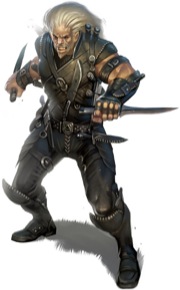 Thus, Count Jeggare’s story is more a journey of romance and intrigue. Radovan faces battle after battle with increasingly powerful opponents. And the third character travels in a world of reincarnated spirits, whispering spiders, cloud-eating goblins, and a few classic monsters you might recognize from your earliest RPG sessions. The three stories still take place in the same world, and there are elements of magic and action in all three, but each has a different sensibility.
Thus, Count Jeggare’s story is more a journey of romance and intrigue. Radovan faces battle after battle with increasingly powerful opponents. And the third character travels in a world of reincarnated spirits, whispering spiders, cloud-eating goblins, and a few classic monsters you might recognize from your earliest RPG sessions. The three stories still take place in the same world, and there are elements of magic and action in all three, but each has a different sensibility.
Also, both Radovan and the Count are pretty flawed heroes. I wanted to add a thread of undiminished heroism through their story, and to my mind that third POV character is that kind of perfect—if unorthodox—hero.
While that third POV fits this story, I don’t know whether I’d automatically include it in a future novel. I love the idea of a third POV character to act as a foil to the boys, but who that is depends on the nature of the story. What seemed a good fit in Master of Devils might not work in another novel.
But never say never.
From reading your blog it seems Master of Devils was influenced heavily by kung fu or wuxia movies. For readers of the novel whose interest is piqued by this novel, what top three wuxia style movies would you recommend to someone relatively new to the genre?
My approach to the novel was to write it for readers who’d never seen (or even haven’t liked) a kung fu movie. I hope those who enjoy the book will check out some of the films I recommend at frabjousdave.blogspot.com. I’ve only about a hundred more to post.
Three of my favorite films representing different aspects of the kung fu genre include Hero, The 36th Chamber of Shaolin, and The Bride with White Hair. It’s hard to recommend just three, because there are so many other must-see movies, especially for gamers. I’ve written a “Kung Fu Movies for Gamers” article for Kobold Quarterly, and I’ll link to more such articles at my blog.
With Prince of Wolves we saw riffle scrolls introduced and Tian Xia seems continue to add to Count Jeggare’s bag of tricks. Do you enjoy finding new ways to use magic within your novels?
I definitely do, although I like it best when the magic is essential to the character—as it is with Jeggare and his fraught history as a wizard—and when it helps make the story more mysterious. If you use only magic whose rules your readers know by heart, it becomes ho-hum. I want the magic in these novels to feel as though it belongs in the Golarion setting but also to keep the readers guessing. Usually I have the game rules in mind, but I try to describe the effects in fresh terms. For example, when Azra heals Radovan in Prince of Wolves, she performs a dancing ritual that reveals a bit of her personality and hints at her unusual background instead of simply “casting cure serious wounds.”
With Master of Devils officially releasing at Gen Con Indy this year, what other projects do you have in the pipeline?
This month paizo.com posts “A Voyage to Absalom,” a free four-part mystery that takes place between Prince of Wolves and Master of Devils. Also, in the Jade Regent Adventure Path, Radovan and the Count follow a trail of bodies through a city in Minkai in “Husks,” the Pathfinder Journal.
The one other project I can mention is a short story in Robin D. Laws’s anthology Shotguns v. Cthulhu, coming out this fall from Stone Skin Press. My contribution is a twitchy little revisionist history centered on the destruction of a famous Seattle landmark in 2002.
____________________
Seekers of Secrets wants to thank Dave for taking the time to answer our questions. It was a pleasure interviewing him. Be sure to follow Dave Gross at his blog to learn more of his upcoming works and to hear more on his kung fu movie recommendations! He has also posted his Gen Con schedule for those who will be at Gen Con. Be sure to swing by the Paizo booth at Gen Con and pick up a copy of Master of Devils and chat with him in person!

